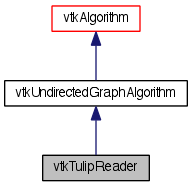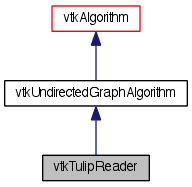Reads tulip graph files. More...
#include <vtkTulipReader.h>


Public Types | |
| typedef vtkUndirectedGraphAlgorithm | Superclass |
Public Member Functions | |
| virtual int | IsA (const char *type) |
| vtkTulipReader * | NewInstance () const |
| void | PrintSelf (ostream &os, vtkIndent indent) |
| virtual char * | GetFileName () |
| virtual void | SetFileName (const char *) |
Static Public Member Functions | |
| static vtkTulipReader * | New () |
| static int | IsTypeOf (const char *type) |
| static vtkTulipReader * | SafeDownCast (vtkObjectBase *o) |
Protected Member Functions | |
| virtual vtkObjectBase * | NewInstanceInternal () const |
| vtkTulipReader () | |
| ~vtkTulipReader () | |
| virtual int | RequestData (vtkInformation *, vtkInformationVector **, vtkInformationVector *) |
| virtual int | FillOutputPortInformation (int port, vtkInformation *info) |
Detailed Description
Reads tulip graph files.
vtkTulipReader reads in files in the Tulip format. Definition of the Tulip file format can be found online at: http://tulip.labri.fr/tlpformat.php An example is the following (nodes 0 1 2 3 4 5 6 7 8 9) (edge 0 0 1) (edge 1 1 2) (edge 2 2 3) (edge 3 3 4) (edge 4 4 5) (edge 5 5 6) (edge 6 6 7) (edge 7 7 8) (edge 8 8 9) (edge 9 9 0) (edge 10 0 5) (edge 11 2 7) (edge 12 4 9) where "nodes" defines all the nodes ids in the graph, and "edge" is a triple of edge id, source vertex id, and target vertex id. The graph is read in as undirected graph. Pedigree ids are set on the output graph's vertices and edges that match the node and edge ids defined in the Tulip file.
Clusters are output as a vtkAnnotationLayers on output port 1. Each cluster name is used to create an annotation layer, and each cluster with that name is added to the layer as a vtkSelectionNode. Nesting hierarchies are treated as if they were flat. See vtkGraphAnnotationLayersFilter for an example of how the clusters can be represented visually.
- Attention:
- Only string, int, and double properties are supported. Display information is discarded.
- Thanks:
- Thanks to Colin Myers, University of Leeds for extending this implementation.
- Tests:
- vtkTulipReader (Tests)
Definition at line 73 of file vtkTulipReader.h.
Member Typedef Documentation
Reimplemented from vtkUndirectedGraphAlgorithm.
Definition at line 77 of file vtkTulipReader.h.
Constructor & Destructor Documentation
| vtkTulipReader::vtkTulipReader | ( | ) | [protected] |
| vtkTulipReader::~vtkTulipReader | ( | ) | [protected] |
Member Function Documentation
| static vtkTulipReader* vtkTulipReader::New | ( | ) | [static] |
Create an object with Debug turned off, modified time initialized to zero, and reference counting on.
Reimplemented from vtkUndirectedGraphAlgorithm.
| static int vtkTulipReader::IsTypeOf | ( | const char * | name | ) | [static] |
Return 1 if this class type is the same type of (or a subclass of) the named class. Returns 0 otherwise. This method works in combination with vtkTypeMacro found in vtkSetGet.h.
Reimplemented from vtkUndirectedGraphAlgorithm.
| virtual int vtkTulipReader::IsA | ( | const char * | name | ) | [virtual] |
Return 1 if this class is the same type of (or a subclass of) the named class. Returns 0 otherwise. This method works in combination with vtkTypeMacro found in vtkSetGet.h.
Reimplemented from vtkUndirectedGraphAlgorithm.
| static vtkTulipReader* vtkTulipReader::SafeDownCast | ( | vtkObjectBase * | o | ) | [static] |
Reimplemented from vtkUndirectedGraphAlgorithm.
| virtual vtkObjectBase* vtkTulipReader::NewInstanceInternal | ( | ) | const [protected, virtual] |
Reimplemented from vtkUndirectedGraphAlgorithm.
| vtkTulipReader* vtkTulipReader::NewInstance | ( | ) | const |
Reimplemented from vtkUndirectedGraphAlgorithm.
| void vtkTulipReader::PrintSelf | ( | ostream & | os, |
| vtkIndent | indent | ||
| ) | [virtual] |
Methods invoked by print to print information about the object including superclasses. Typically not called by the user (use Print() instead) but used in the hierarchical print process to combine the output of several classes.
Reimplemented from vtkUndirectedGraphAlgorithm.
| virtual char* vtkTulipReader::GetFileName | ( | ) | [virtual] |
The Tulip file name.
| virtual void vtkTulipReader::SetFileName | ( | const char * | ) | [virtual] |
The Tulip file name.
| virtual int vtkTulipReader::RequestData | ( | vtkInformation * | request, |
| vtkInformationVector ** | inputVector, | ||
| vtkInformationVector * | outputVector | ||
| ) | [protected, virtual] |
This is called by the superclass. This is the method you should override.
Reimplemented from vtkUndirectedGraphAlgorithm.
| virtual int vtkTulipReader::FillOutputPortInformation | ( | int | port, |
| vtkInformation * | info | ||
| ) | [protected, virtual] |
Set the outputs to vtkUndirectedGraph and vtkAnnotationLayers.
Reimplemented from vtkUndirectedGraphAlgorithm.
The documentation for this class was generated from the following file:
- dox/IO/Infovis/vtkTulipReader.h
 1.8.0
1.8.0